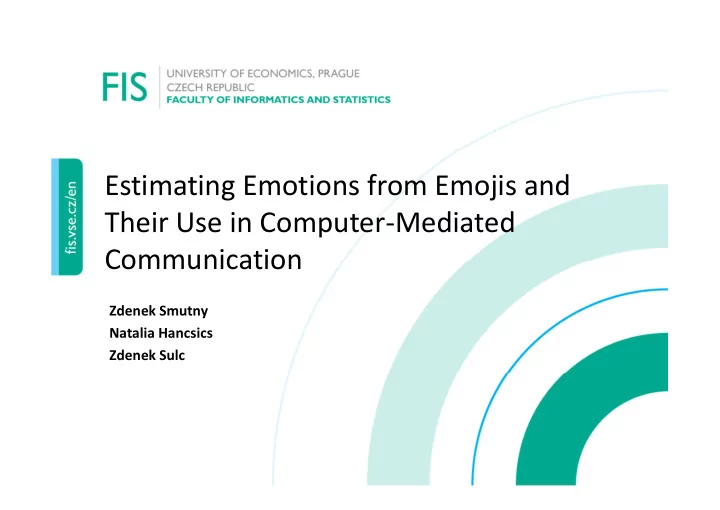

Estimating Emotions from Emojis and Their Use in Computer-Mediated Communication Zdenek Smutny Natalia Hancsics Zdenek Sulc
The aim of the paper • Compare the ability to estimate emotions in a sentence and assign the correct emoji to an emotionally colored sentence in representatives of generations Y and Z in the Czech and Slovak Republics. • Analyze the meaning of selected emojis in text messages in remote communication and their interpretation by representatives of Generation Z and Y. 2
Materials and methods An online questionnaire was published in a period from 11 November 2018 to 26 December to answer 3 research questions (RO). In total 863 respondents. Age limitations: • Generation Y (born 1988–1995) - 456 respondents • Generation Z (born1996–2003) - 407 respondents
4 basic human emotions Anger, joy, fear and surprise were chosen because of their easy recognition by a human in everyday life: 😢 – anger 😲 – fear 😋 – joy 😳 – surprise 4
Results • Most commonly used is emoji expressing joy (78.0%), and the least used is emoji expressing anger (48.3%). • Differences in frequency of use between generations Y and Z are negligible, both generations use or do not use emojis almost as often. • Women use emoji expressing joy more often than men (83.5% vs 62.6%). 5
Recognition based on the texts to choose the most appropriate emotions for the selected sentences, which the given sentence expresses. • Was very successful • Confusion between joy and surprise • Generation Y were more successful in recognizing joy • No differences in the case of gender 6
Recognition based on the emoji to assign to a certain sentence the most suitable emoji expressing the emotion that is carried in the text. • Was less successful • Generation Z performed better in all four cases • No significant differences were found between men and women.
Discussion and conclusions RQ 1: Does the presence of emoji in a text message have a positive effect on recognizing emotion implicitly carried by the message? • The problem of interpretation of the message is not necessarily on the side of the recipient, but also on the side of the sender. • A certain emoji does not necessarily represent an authentic expression of the emotional state of the sender. • The respondents had better results when they assigned emotions to a certain sentence. 8
Discussion and conclusions RQ 2: Do the representatives of the younger Generation Z estimate the emotions of another person at CMC better than the representatives of the older Generation Y? • The results of both generations were very similar. Minor differences were identified only in the case of selecting appropriate emoji for a particular sentence, where representatives of the Generation Z performed better in all four emojis. 9
Discussion and conclusions RQ 3: Do women estimate emotions better than men? • Men were better able to recognize anger and women other emotions. • Women are also associated with the appropriate use of emoji (the emotional charge of the text corresponds to the emotional charge carried by the emoji) 10
Questions? 11
Recommend
More recommend